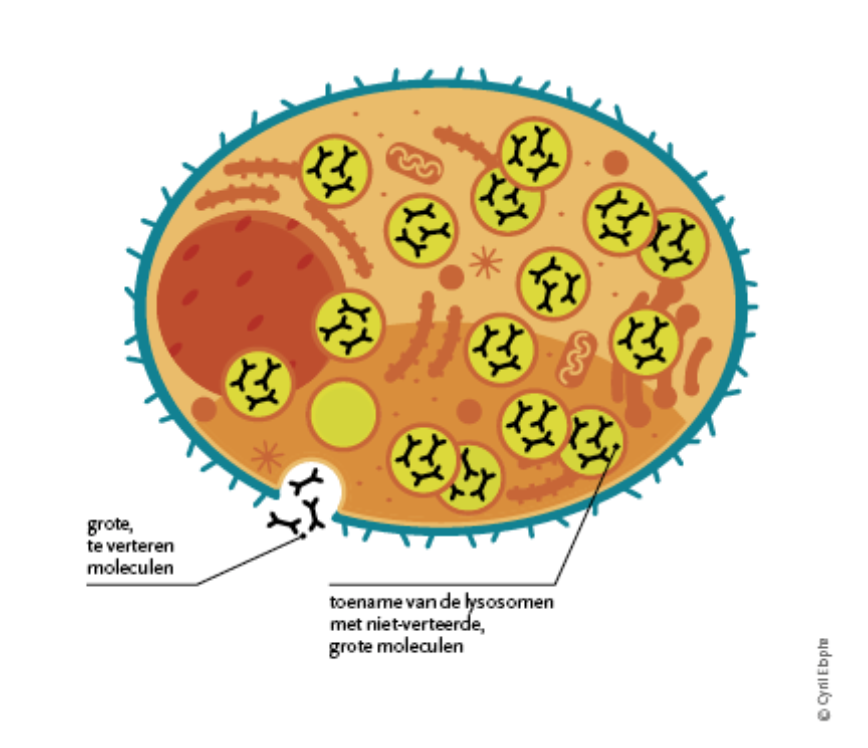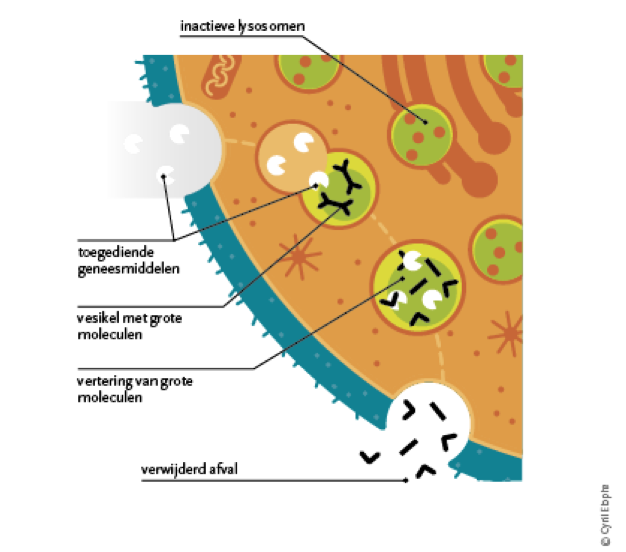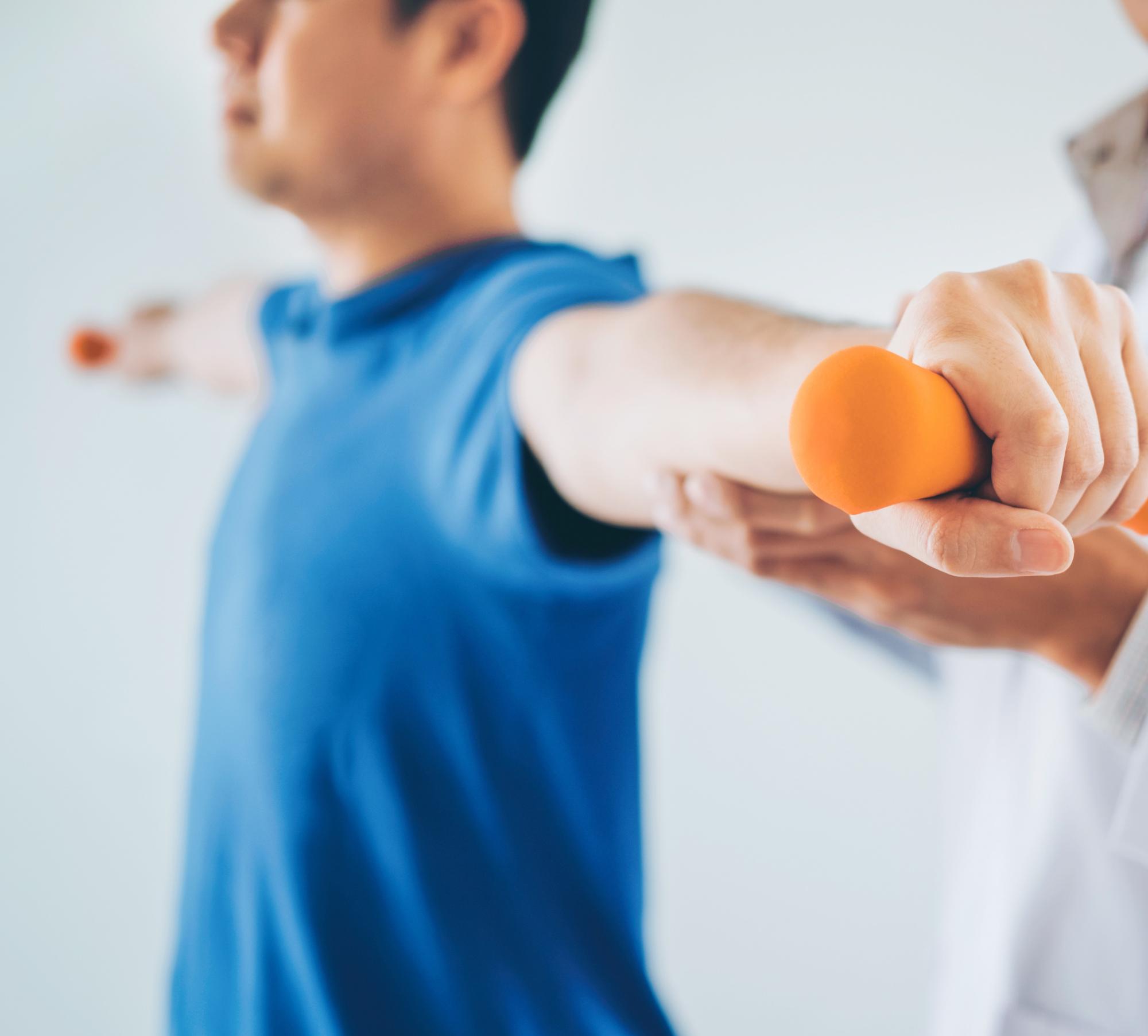Is there a treatment for Pompe disease?
Individuals with lysosomal storage diseases cannot produce sufficient specific enzymes for the body to work properly. These enzymes, which cause the breakdown of a large number of different types of substances, are not present at all or only in very small quantities.
The result is an accumulation of material that disrupts the normal functioning of the cells, affecting organs, which can lead to life-threatening problems.
The diagram below explains the processes behind a lysosomal storage disorder.
In Pompe disease, the body is unable to produce the enzyme alpha-glucosidase needed to break down certain wastes. Researchers have developed a treatment to replace that enzyme in the body: enzyme replacement therapy.
Since April 2006 enzyme replacement therapy has been available in Belgium for the treatment of Pompe disease.
Enzyme replacement therapy
In this therapy, the missing lysosomal enzyme is replaced by infusions with an enzyme that is very similar to the missing, human enzyme.
The treatment consists of regular infusions of the missing enzyme to ensure that the metabolism (metabolism) can return to normal and that the waste products no longer accumulate.
Enzyme replacement therapy is given once every two weeks, administration of the infusion takes a few hours (depending on the weight of the patient).
There is increasing evidence that the sooner the first symptoms start the therapy, the better the results will be. The course of the disease can be delayed or changed and late complications can be avoided, which can significantly improve the quality of life of many patients.
Below are various forms of supportive care that can improve the quality of life of patients with Pompe disease.
Nutritional therapy
Many patients can hardly maintain a healthy body weight because they have difficulty eating. To tackle this problem, many doctors prescribe a specialized diet with a high protein and low carbohydrate content, which has benefited a number of patients. [1, 2, 3] That diet can in certain cases be supplemented with amino acids (the building blocks of proteins). [4]
However, a nutritional therapy does not produce clear results. A 1997 study found that only 25% of patients with Pompe disease who followed a high-protein diet showed improved breathing or skeletal muscle function. [5]
Patients who struggle to maintain a healthy body weight sometimes need tube feeding so that they absorb enough calories every day. Tube feeding may also be appropriate when a patient is unable to swallow properly or uses a ventilator for breathing. Tube feeding can be administered via the nose, if it is a temporary solution, or via the stomach, if that has to happen longer term. Tube feeding is more often needed in patients who have had the disease from an early age due to their severe muscle relaxation. Patients and their families should consult their doctor and / or a licensed dietitian who can determine how many calories they should take every day. This recording is determined by different variables, such as age, body height and health status.
Breathing therapy
Because of the severe weakening of the muscles that support the lungs, a doctor can suggest to the patient respiratory therapy. Many patients with Pompe disease will eventually need mechanical ventilation to support or take over their breathing, and in acute cases even to combat respiratory failure.
Mechanical ventilation devices are pumps that bring warmed, humidified air to the lungs with varying pressure. In some cases, a ventilator is only needed at night in the beginning. As the disease progresses, however, it is possible that patients also need more and more respiratory assistance during the day. There are different types of ventilation equipment and methods, depending on the patient's need and his ability to breathe spontaneously. Patients who are strong enough to breathe themselves may prefer a respirator that follows their own breathing pattern. Others will need a respirator that has been programmed to deliver 'breathing' in pre-set cycles.
Patients whose respiratory problems are getting worse, usually start with non-invasive ventilation devices that supply air through a mask that fits the nose, mouth or both. The advantage of such masks is that they are convenient, portable and inexpensive. Patients can only use these devices after they have received explanations from their doctor (usually in the hospital) or a respiratory therapist (possibly at home). That therapist usually follows the patient for several weeks to ensure that the mask fits properly (no leaks) and to adjust the settings of the ventilator. Ventilation using a mask on the face is usually not suitable for patients with claustrophobia, small children, patients with excessive secretions or swallowing problems, or patients who require more intensive support of breathing.
In other cases, patients can only start with mechanical ventilation if they are admitted to hospital for their respiratory insufficiency. In these acute situations, doctors will usually intubate the patient; through the mouth or nose they insert a tube directly into the lung (trachea). In this more invasive form of mechanical ventilation, processed and oxygen-enriched air can be brought directly to the lungs. Once the breath is stable again, the doctors will gradually "wipe" the patients from that assisted breathing to see if they can breathe on their own, or for a part of the day.
Although no definitive guidelines have been established, patients who require mechanical respiration 24 hours a day for a longer period of time may be eligible for tracheostomy. This is a surgical procedure in which a permanent air duct is made through the trachea in the throat. [6] A tube is then inserted into the opening to bring air to the lungs. Most modern 'trachs', as they are often called, have valves that allow the patient to talk when connected to the device. With tracheostomy the patient feels more comfortable and he / she is better able to participate in the rehabilitation programs
Another component of respiratory therapy is IPPB (intermittent positive pressure breathing - intermittent positive pressure breathing). This treatment can be given by a respiratory therapist in the hospital, a clinic or at home. During this 10 to 15-minute assisted breathing, the patient inhales through a mouthpiece while the IPPB machine presses air into the lungs to open it. The patient breathes for a few seconds before exhaling slowly and that procedure is repeated until the session is over. IPPB helps the patient to breathe deeper and can be used to administer aerosol drugs such as mucolytics (mucus thinners) to the lungs.
Physical activity and physiotherapy
Doctors can also prescribe a specific exercise program for patients with Pompe disease. [7] When the patient starts it early , he can stay in shape and keep his / her strength. However, before the patient can begin these exercises, the doctors will take a number of tests to determine the tolerance of exercise or to determine what effort the patient can handle at that moment. Based on these results, one can then draw up a physical exercise program, tailored to the needs and abilities of that patient. This program usually focuses on sub-maximal aerobic exercise, with exercises on a treadmill or an exercise bike, for example. You should always consult your doctor before starting an exercise program.
Patients with Pompe disease may also benefit from physiotherapy. Through physiotherapy, young children with muscle relaxation can learn how to move and interact with their environment. The physiotherapists also teach the parents methods that can promote the growth and development of a young child. As Pompe disease progresses, physical therapy can help the patient to keep moving and stay strong so that daily activities are easier and the inconveniences of musculoskeletal changes are kept to a minimum. The patient can also perform specific exercises to build up a greater resistance, such as exercises for the respiratory muscles. These help patients with weakened breathing to develop strong respiratory muscles.
There is support equipment where a physiotherapist can help a patient with Pompe disease learn to work. Many people with weakened leg, pelvis and trunk muscles use supporting equipment to stay mobile. There are patients who benefit from orthoses - braces that support the ankle and foot or are applied over the knee - while others are better with a walking stick, a walking frame or a wheelchair to get to their destination. There are also other tools to stay mobile and to use in the home, such as a shower wheelchair or a hoist. These devices can be very useful for the patient and his family when the disease is more advanced.
Preventive therapy
The prevention of infections is an important part of the care of patients with Pompe disease. Since most patients still have some degree of respiratory insufficiency, they are extremely susceptible to pneumonitis. Each infection must therefore be treated immediately before it reaches a critical stage. If an infection becomes worse despite all the measures taken, patients often need respiratory support to help them through the period of the weakened lung function that can result from the infection.
References
- Slonim AE, Coleman RA, McElligot MA, et al. Improvement of muscle function in acid maltase deficiency by high-protein diet. Neurology 1983; 33: 34. Umpleby AM, Wiles CM, Trend PS et al. Protein turnover in acid maltase deficiency before and after treatment with a high protein diet. J Neurol Neurosurg Psychiatry 1987 May;50(5):587-92.
- Demey HE, Van Meerbeeck JP, Vandewoude MF, et al. Respiratory insufficiency in acid maltase deficiency: the effect of high protein diet. J Parenter Enteral Nutr 1989 May-Jun; 13(3): 321-3.
- Mobarhan S, Pintozzi RL, Damle P, et al. Treatment of acid maltase deficiency with a diet high in branched-chain amino acids. J Parenter Enteral Nutr 1990 Mar-Apr; 14 (2): 210-2.
- Bodamer OAF, Leonard JV, Halliday D. Dietary treatment in late-onset acid maltase deficiency. Eur J Pediatr 1997; 156: S39.
- Harrison’s Online. Chapter 266: Mechanical Ventilatory Support. The McGraw-Hill Companies. 2001-2001.
- Persoonlijke communicatie met Jennifer Hofstein, MS, RD, en Alfred Slonim, MD, aan het North Shore University Hospital Pediatric Endocrinology & Metabolism, Manhasset, New York.




